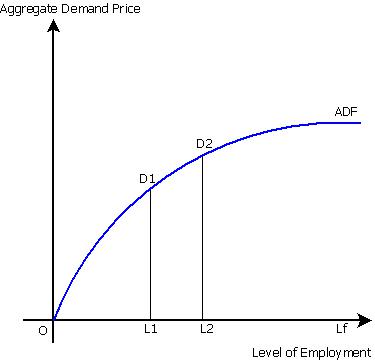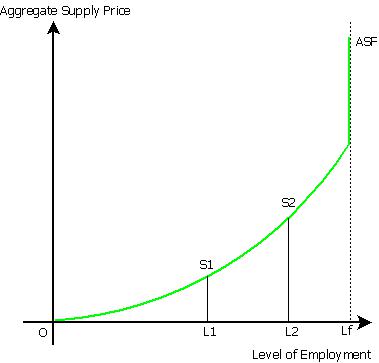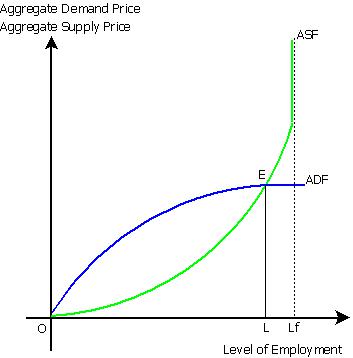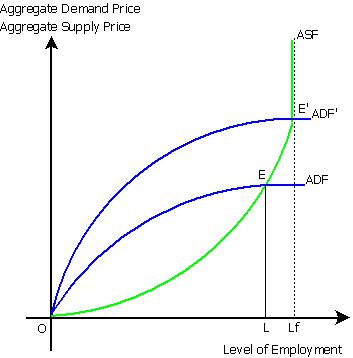KEYNES'S THEORY OF AGGREGATE DEMAND
MACROECONOMICS

|
KEYNES'S THEORY OF AGGREGATE DEMAND |

|
Introduction |
John Maynard Keynes is often referred to as the father of macroeconomics. His pioneering work "The General Theory of Employment, Interest and Money" published in 1936, provided a completely new approach to the modern study of macroeconomics. It served as a guide for both macroeconomic theory and macroeconomic policy making during the Great Depression and the period later. The General Theory was a beginning of a new school of thought in macroeconomics which was referred to in later period as Keynesian Revolution in macroeconomic analysis.
The notion of “effective demand” and its influence on economic activity was the central theme in Keynes's Theory of Effective Demand. While refuting the Classical theory which believed in strong general tendency of market mechanism to move output and employment towards full employment, Keynes explained that, in some situations, no strong automatic mechanism moves output and employment towards full employment levels. Keynes was the first economist to advocate the role of government especially fiscal policy, as the primary means of stabilizing the economy.
| Meaning of Aggregate Demand |
The concept of aggregate demand (AD) refers to the total demand for goods and services in an economy. Effective Demand is related to the total expenditure flow in an economy in a given period. It consists of the following:
Consumption demand by the households (C )
Investment demand, i.e., demand for capital goods (I) by the business firms.
Government expenditure (G)
Net income from abroad (X – M).
Thus symbolically,
Effective Demand = C + I + G + (X-M)
| Keynes's Theory of Aggregate Demand |
According to Keynes full employment is not a normal situation as stated in the Classical theory. He argued that economy's equilibrium level of output and employment may not always correspond to the full employment level of income. It is possible to have macroeconomic equilibrium at less than full employment. If current level of aggregate demand (expenditure) is not adequate to purchase all the goods produced in the economy (i. e . a situation of excess supply) then output will be cut back to match the level of aggregate demand.
Keynes's theory of the determination of equilibrium income and employment focuses on the relationship between aggregate demand (AD) and aggregate supply (AS). According to him equilibrium employment (income) is determined by the level of aggregate demand (AD) in the economy, given the level of aggregate supply (AS). Thus, the equilibrium level of employment is the level at which aggregate supply is consistent with the current level of aggregate demand. The theory believes that "demand creates its own supply" rather than the Classical claim of "supply creates its own demand".
In the following sections we discuss Keynes' concepts of aggregate demand function, aggregate supply function and finally, the point of effective demand.
| Aggregate Demand Function |
Aggregate demand or what is called aggregate demand price is the amount of total receipts which all the firms expect to receive from the sale of output produced by a given number of workers employed. Aggregate demand increases with increase in the number of workers employed. The aggregate demand function curve is a rising curve as shown in Fig. 1.
It can be seen that total expected receipts is D1L1 at OL1 level of employment. Total expected receipts increase to D2L2 with increase in the level of employment to OL2. OLf is the full employment level. Initially the aggregate demand function (ADF) rises sharply as increase in the number of employment leads to increase in society's expenditure, thereby, increasing producer's expected sales receipts. There is no much increase in employment, income, expenditure and therefore producer's expected sales receipts as the economy reaches near full-employment. The ADF curve becomes perfectly elastic (horizontal) as the economy reaches near full-employment.
Aggregate Demand In Keynes’ theory of income determination is society’s planned expenditure. In a laissez-faire economy it consists of consumption expenditure (C)and investment expenditure (I).
Thus AD = Planned Expenditure = C + I
where,
C = f (Yd)and Yd is level of disposable income (Income minus Taxes)
I is exogenous in the short run.
The short-run aggregate demand function can be written as
| Aggregate Supply Function |
Aggregate supply is determined by physical and technical conditions of production. However, these conditions remain constant in the short run. As such, given the technical conditions, output in the short run can be increases only by increasing employment of labour.
Aggregate supply or what is called aggregate supply price is the amount of total receipts which all the firms must expect to receive from the sale of output produced by a given number of workers employed. In other words, aggregate supply price is the total cost of production incurred by producers by employing a certain given number of workers. Obviously, aggregate supply price increases with increase in the number of workers employed. The aggregate supply function curve is a rising curve and at full employment (OLf) it becomes perfectly inelastic (vertical) as shown in Fig. 2.
It can be seen that aggregate supply price or the cost of production is S1L1 at OL1 level of employment. It increase to S2L2 with increase in the level of employment to OL2. Initially, the aggregate supply function (ASF) rises slowly as labour is abundant thereby leading to slow increase in the cost of production. Larour cost rises sharply as the economy reaches near full-employment. The ASF therefore rises sharply and at full employment (OLf) it becomes perfectly inelastic (vertical).
| Determination of Equilibrium Level of Employment |
According to Keynes equilibrium level of employment (income) in the short run is determined by the level of effective demand. The higher the level of effective demand, the greater would be the level of income and employment and vice versa. This is shown in Fig. 3.
Fig.3 shows the ADF and ASF together. As discussed above the ADF shows the amount of total receipts which all the firms expect to receive from the sale of output produced by a given number of workers employed and the ASF shows the amount of total receipts which all the firms must expect to receive from the sale of output produced by a given number of workers employed. Entrepreneurs expand output as long as there are opportunities to make profits.
It can be seen that up to OL level of employment, aggregate demand price is greater than aggregate supply price (ADF > ASF). Producers expect greater returns than the cost of production. As such, producers expand output up to OL level of employment. Thus at any level of employment up to OL, there would be expansionary tendency in the economy and therefore rise in the level of employment.
Beyond OL level of employment, aggregate demand price is less than aggregate supply price (ADF < ASF). Producers expect less returns than the cost of production. As such, producers prefer to cut down output. Thus at any level of employment beyond OL, there would be contractionary tendency in the economy and therefore fall in the level of employment.
At OL level of employment aggregate demand price equals aggregate supply price (ADF = ASF). Now there is no tendency towards economic expansion or contraction. Thus OL is the equilibrium level of employment. Point 'E' is called the point of effective demand. It represents that level of aggregate demand price that is equal to aggregate supply price and thus reaches short run equilibrium position.
It can be seen that equilibrium point 'E' is established at less-than-full employment equilibrium and there is LLf amount of involuntary unemployment in the economy. It is important to note that according to Keynes this unemployment is due to deficiency of aggregate demand. At full employment level there exist a gap between the full-employment level of aggregate supply price and the corresponding level of aggregate demand price.
| Role of Fiscal Policy in achieving Full-Employment Equilibrium |
According to Keynes, full-employment can be achieved by removing the gap between aggregate supply price and aggregate demand price. However, he rejected the Pigouvian wage-cut solution to pull the ASF downwards to achieve full-employment. This, according to him, would further lower the aggregate demand, if the income of potential customers is reduced. The economy, in short, will be caught in a vicious circle of high unemployment and low demand. On the other hand, the policy to push the ADF upwards will push the economy into a virtuous cycle of high demand and high employment. This is shown in Fig. 4.
It can be seen that the gap between the full-employment level of aggregate supply price and the corresponding level of aggregate demand price is now filled by shifting the ADF upwards to ADF'. The economy is now at full-employment equilibrium point E' and equilibrium employment is OLf.
Keynes argued that adequate economic stimulus to shift the ADF upwards can be created through:
1. The Monetary Policy: A reduction in interest rates
2. The Fiscal Policy: A rise in government expenditure
However, to Keynes, monetary policy would be less effective under the conditions of economic depression. It is a situation when community's liquidity preference curve is absolutely elastic (horizontal). Therefore, interest rate, which is already at low levels, cannot be lowered further through the expansion of money supply. Thus, expansionary monetary policy would fail to generate economic stimulus by picking up investment. On the other hand, expansionary fiscal policy would be more effective to achieve upwards shift in the aggregate demand and thereby full employment and output. Keynes developed the theory of investment multiplier to explain the impact of government expenditure on income and employment.
Thus, Keynes advocated government's intervention through countercyclical fiscal policies. He suggested expansionary fiscal policy or deficit spending when a nation's economy suffers from recession or is caught in the vicious cycle of high unemployment and low aggregate demand, and contractionary fiscal policy by increasing taxes or cutting back on government outlays to suppress inflation in boom times. He argued that governments should solve problems in the short run rather than waiting for market forces to do it in the long run, because, "in the long run, we are all dead."
The short-run aggregate demand function can now be written as:
where, G is government policy variable.

|
Activity |

|
Key Terms |
XXXXXX XXXXXXX
XXXXXX XXXXXXXXX

|
Results |
- }}
Keynes, John Maynard (1924). "The Theory of Money and the Foreign Exchanges". A Tract on Monetary Reform






